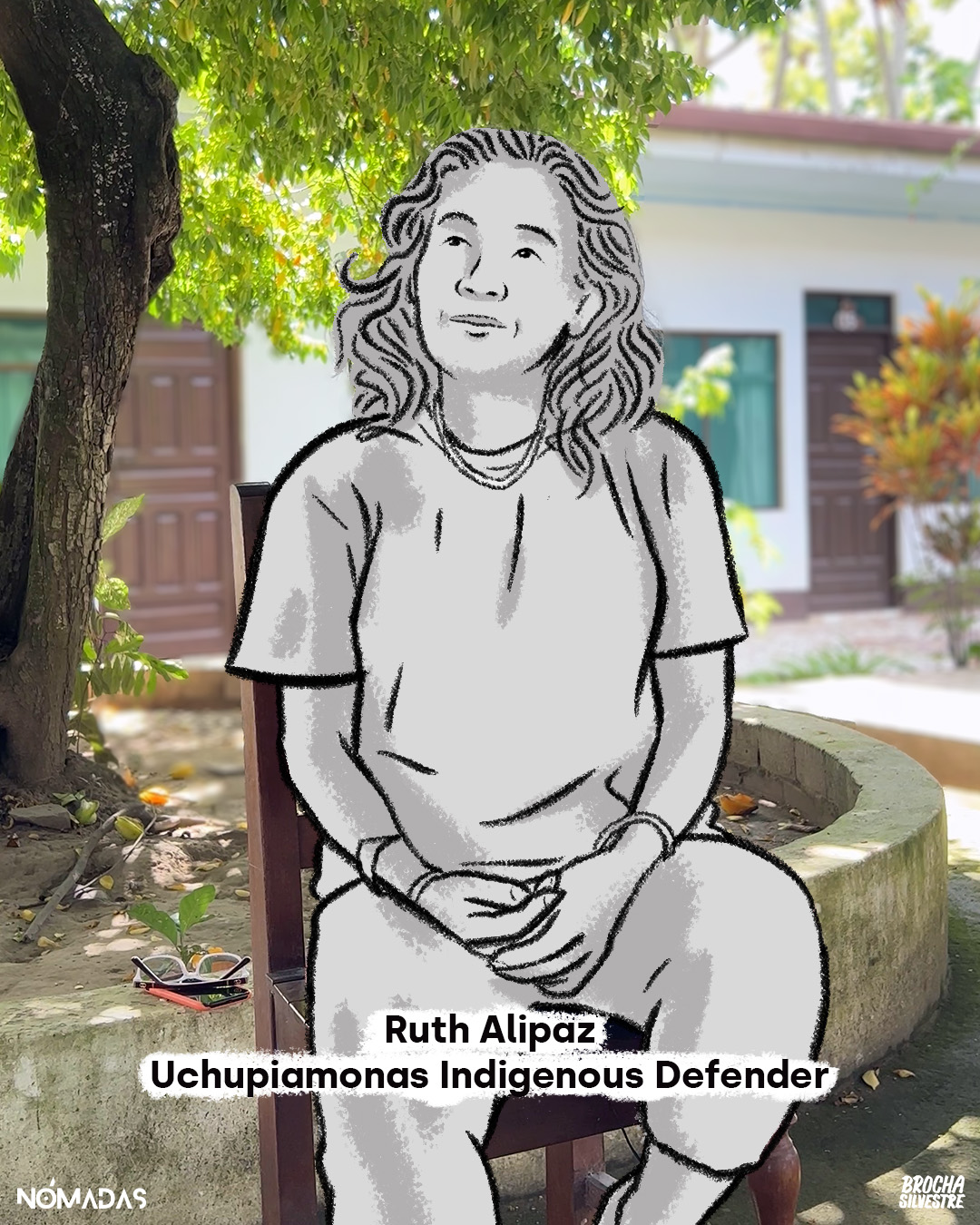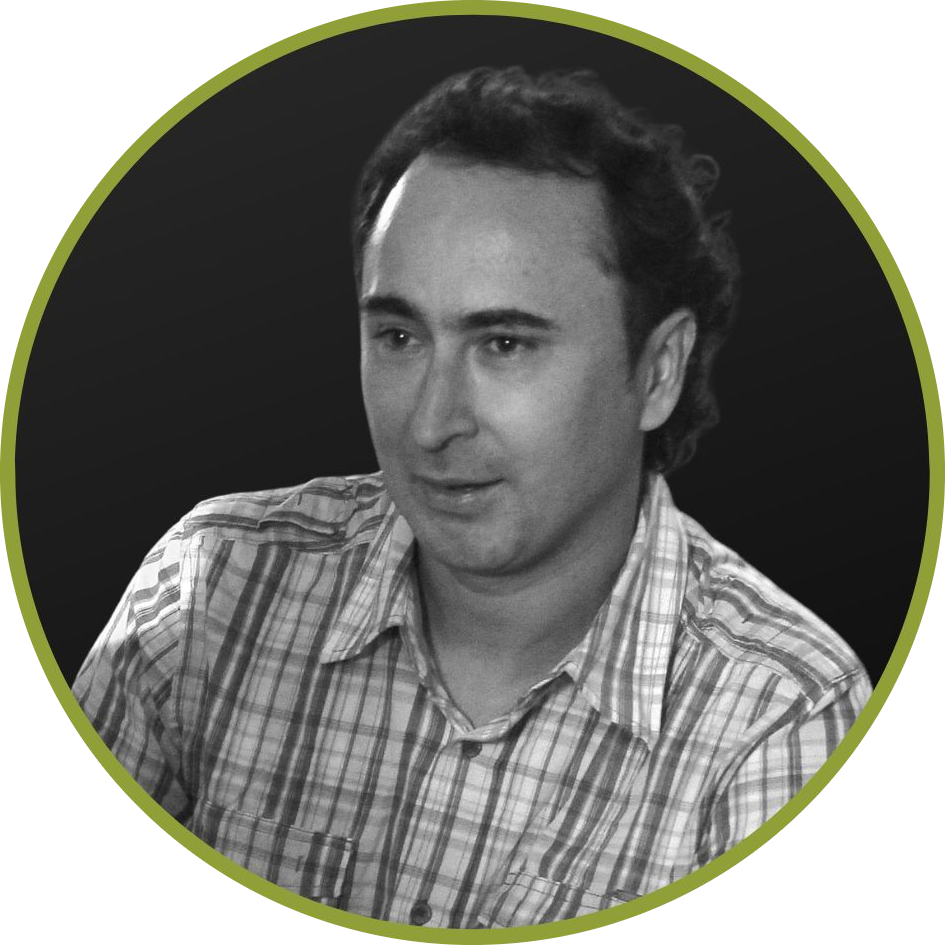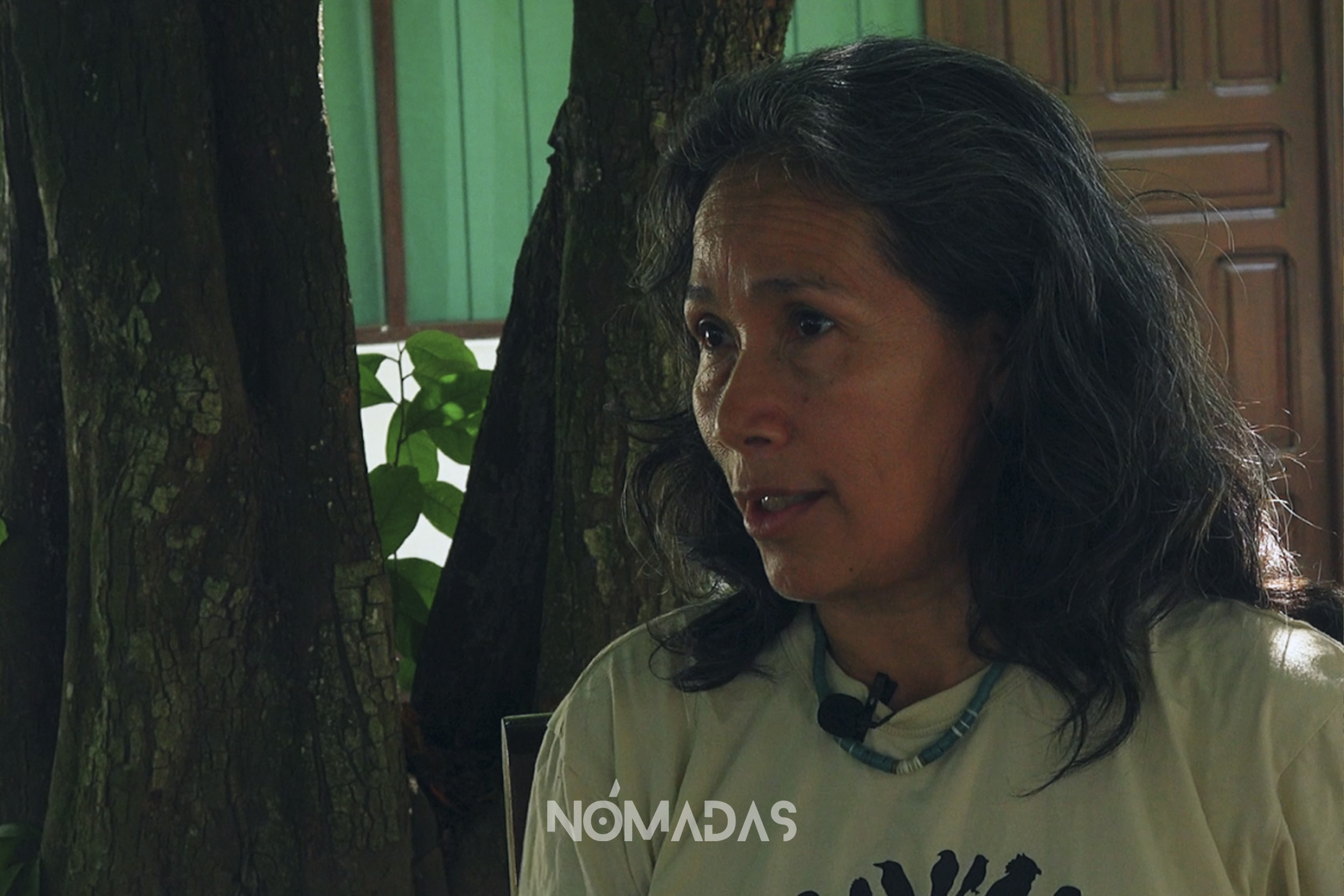ENGLISH


ENGLISH
INTERVIEW
Ruth Alipaz has led the resistance against destructive projects such as hydroelectric dams and mining, fighting for the preservation of the Bolivian Amazon and its diverse bird species while advocating for the rights of indigenous peoples and environmental protection. Her voice highlights the dangerous process of extermination that indigenous peoples face and how they are left without water and food.
August 21th, 2023


Roberto Navia Gabriel
Journalist
-How many years have you been fighting for nature?
-Since I was 12 years old because indigenous peoples were always condemned as we didn’t have access to a complete education with high school. At that time, education only went up to fifth grade, and I had to seek ways to finish my schooling. It meant breaking many paradigms, social structures, and rules, which were not well-accepted, especially for a young girl.
I remember we were on the verge of approving a 31,000-hectare forest concession in my territory, and this led me to confront the interests of large capital from timber exploitation that always convinced the authorities of our communities that destroying the forest was a good idea.
With my personal background, I worked with indigenous communities in the north of La Paz, in the Apolo region, and also in the southern part, near the Cochabamba border, implementing community-based ecotourism projects, which led me to start a specialized birdwatching agency.
This allowed me to support young people conducting comparative studies of foothills in Bolivia, defining that Sadiri mountain range, in Madidi, was the most biodiverse foothill in terms of birds. That prompted me to propose an alternative to my community, telling them that we cannot destroy this area, and that’s how the idea of a birdwatching project came about.
Out of this project, Sadiri Lodge was born, located in the Sadiri mountain range within Uchupiamonas territory. This brought me closer to the threats posed by the El Chepete and El Bala hydroelectric projects in 2015 when the government signed an agreement for their construction. We rejected the projects, and that started our involvement with the organization called the Indigenous Communities Consortium of the Beni, Tuichi, and Quiquibey Rivers Basin, comprising 18 indigenous communities of six different nationalities: Mosetén, Chimán, Esse Ejja, Leco, Tacana, and us, the Uchupiamonas, who have historically inhabited the Tuichi River valley. We became part of the board of the consortium, leading the fight against the El Bala and El Chepete hydroelectric projects. Over time, I focused more on the struggle for the rights of indigenous peoples, nature, and protected areas, even giving up my economic activities.
I remember that we were about to approve a concession of 31,000 hectares of forest in my territory, this led me to confront the interests of large capital in timber exploitation.
-Have you faced a lot of threats?
-Yes, we normalize and accept the attacks we suffer. For example, when we opposed the forest concession in my territory, we had to face the men of the village who tried to impose their will, sometimes with violence. This occurred at that time, and for me, experiencing a threat of physical aggression was like «that’s how it’s supposed to be.» But when women reacted in support, I saw that we are not willing to generate that type of violence.
When I went to the United Nations in 2018 to denounce the lack of free and informed consultation for our peoples, I immediately started receiving threats through various means, saying that I was a liar, pretending to be indigenous, a businesswoman, and to be careful. That was the first national-level threat from people I didn’t even know. Later, with the mining issue, I received threats; they seek to discipline you by instilling fear so that you won’t resist. They send messages saying that mining will come whether you like it or not, and they will blow your head off with dynamite to see if you’ll keep resisting. These threats are very public, sent through WhatsApp groups.
I was told that I’m entering a more dangerous territory because mining is linked to other illicit activities like drug trafficking or human trafficking. There are also common practices of organizations affiliated with the government that slander and defame us, trying to discredit us.
My partner and fellow comrade in the fight is Alex Villca. We are relatives, and they consider that a crime because they target and violate our personal space to criminalize us, and even authorities engage in this behavior. Once, a former minister held a press conference using his public and political power to say that Paula Gareca, the great defender of the Tariquía Protected Area (Tarija department), was financing the big march of the Qara Qara Nation in 2019. He said that we were defending indigenous and original justice to protect criminals who had committed murders.
-What precautions do you take in the face of the threats you receive?
-I try to lead a normal life, but I’ve learned to be aware that defenders like us have been deprived of the right to have a family lunch or celebrate birthdays. There are photos with and without our loved ones. These situations affect your personal life, and you have to protect your family and close friends because that’s where they can hurt you the most. You become more conscious that this is part of the struggle, and you have to face that type of violence.
-How is the health of Madidi National Park?
-It is an extraordinary protected area, incredibly biodiverse. Indigenous peoples have contributed significantly to the declaration of Madidi National Park as a protected area. In the 1990s, my community, San José de Uchupiamonas, ventured into community-based ecotourism before it was declared a protected area, aiming to preserve its natural resources. At that time, there was a boom in illegal logging of mara and cedar woods. I remember that up to 70 «callapos» (wooden rafts) per day would float down the Tuichi and Beni rivers. My community decided to protect and halt that activity, which also contributed to safeguarding and preserving the area.
Madidi has a wide altitudinal variation, from 6,000 meters to 200 meters above sea level, which gives you an idea of the rich biodiversity it possesses. However, that same richness also makes it vulnerable to significant threats. For instance, in my territory, covering 211,000 hectares, 98% is under concession for oil exploration. There is the threat of the El Bala and El Chepete hydroelectric projects, and the entire Tuichi River is under concession for alluvial gold mining.
Last year, in late October 2021, along with the National Coordination for the Defense of Indigenous Origin Campesino Territories and Protected Areas (CONTIOCAP), we conducted a pollution study and found that most of our communities are contaminated with high levels of mercury.
The health of the population living inside and near Madidi is directly related to the health of the protected area. It faces immense threats and, above all, there are many interests in revoking the decree that designates it as a protected area.
-Which decree are you referring to?
-The one designating Madidi National Park as a protected area. This process started gradually from 2014 when the management plan of the protected area was changed. Later, the mining law was decreed without consulting the indigenous peoples, and, undoubtedly, this law is wholly discriminatory towards us as it eliminates the right to free and informed consultation.
-Here, does power abuse its power?
-If we talk about rights, certainly, whether it’s about people or nature, in this case, it’s a progressive issue. Article 385 of the Constitution clearly states that «protected areas are a common good and form part of the natural and cultural heritage of the country; they fulfill environmental, cultural, social, and economic functions for sustainable development.» There is no other law above the Constitution, and all Bolivians should be aware and understand it. However, miners arrive at our communities with the false story that they have authorization, and that the law allows them to extract gold from our rivers, our territory, and the protected area.
-How did you determine the pollution levels in the rivers?
-In 2019, I participated in a workshop organized by the Center for Documentation and Information of Bolivia (CEDIB) in coordination with the University of Cartagena. At that time, we didn’t know that alluvial mining used mercury. It was somewhat anecdotal because in that workshop, there were people from communities living on the banks of the Beni River. When the toxicology expert, Dr. Jesús Oliveiro, explained the effects of mercury on any living organism’s body, they had records of fish they had caught from the river with wounds on their backs, showing that they could generate bruises or sores.
During the workshop, I learned that there was a way to find out if you were contaminated with mercury, and at the end of the session, they said that those who wanted to take a sample could do it voluntarily. I took a sample, thinking I had no mercury, but later I discovered that I had more than twice the permitted level of mercury in my body, according to the World Health Organization (WHO) standards.
This alarmed me, and we coordinated with CONTIOCAP and CEDIB to conduct the study in 2021, and we found that we all had mercury in our bodies. We presented these results to the Inter-American Commission on Human Rights (CIDH) and met with the Special Rapporteur on hazardous substances, Marco Orellana, in La Paz. The Esse Ejja people and all the communities said they had been experiencing symptoms for some time. Currently, we have requests for help from an Esse Ejja sister who bleeds if not medicated. So, where is the state to address these health issues that are already manifesting? Esse Ejja children have skin protuberances, but the government hasn’t done anything. They only said there are indications of contamination. In January, they presented a plan to reduce mercury, but again, they didn’t include the indigenous peoples, only mentioning mining centers. It seems that our sector doesn’t matter to the state.
That has allowed me to support young people who were conducting comparative studies of foothills in Bolivia, this study defined that the Sadiri mountain range in Madidi was the most biodiverse foothill area in terms of birds.
-What are the symptoms of a person contaminated with mercury?
-One of the effects is diarrhea and fever. Since 2019, I have been suffering from diarrhea, and doctors couldn’t diagnose me. I tried many treatments to improve my condition. I have these symptoms, and the tests are expensive. In Bolivia, there are no experts to provide that kind of diagnosis.
-Is gold mining taking place within Madidi, its watersheds, or around it?
-In the Apolo region, they are already within Madidi. Specifically, the Leco indigenous community, known as Virgen del Rosario, is located within Madidi, as well as the Pata community. But mainly, the Virgen del Rosario community is engaged in mining. They have introduced heavy machinery, and they have even threatened park rangers with firearms.

The strong voice of Ruth Alipaz confirms her commitment to the forests.
– Are they cooperative members?
-Well, now they are mining cooperatives.
– Aren’t they indigenous?
-They are indigenous Lecos, living in Virgen del Rosario. I know their community. In 2019, we did a white water descent down the Tuichi River, partly to raise awareness about the issues in Madidi, as we could see the threat of mining coming. At that time, we were also fighting against the construction of the El Bala and El Chepete hydroelectric projects.
During that descent, I foresaw that it might be the last time we could freely navigate the Tuichi River and that it would be very difficult in the future. And that’s exactly what happened last year; we couldn’t enter to descend from there. Now, Virgen del Rosario is inside Madidi, and if they reach the Azariamas community, they would be very close to the core area of Madidi, which is close to my community, San José de Uchupiamonas, an area of maximum protection. So, it seems like an imminent threat if the government doesn’t take appropriate actions.
– How is it understood that indigenous people are also involved in destroying the park through mining?
-This issue is a bit more profound. It has been going on for many years, through previous governments, which failed to generate economic activities that would allow communities to have a dignified life. In my community, we have been involved in ecotourism since the 1990s, but other communities farther away haven’t had access to plans and projects. The purpose of the Indigenous Fund was to benefit indigenous peoples, but this didn’t happen. Thus, there are needs and economic pressure.
In 2019, during the descent, we saw that our communities have always been involved in mining, but in an artisanal way. However, since Law 535 was enacted, combined with the pandemic, and the former Bolivian president Jeanine Áñez provided incentives for mining as an economic reactivation activity, they have been boosting aggressive mining.
Entrepreneurs have come to my community and offered 30% royalties and benefits, and the communities think that by engaging in large-scale mining, they will escape poverty. However, what we have seen in the Guanay or Mapiri area is the opposite; mining only leaves more poverty.
– Are there major capitalists behind it?
-Without a doubt, there are major capitals behind it, using small cooperatives as a front. It’s even better if they are cooperatives of indigenous communities, claiming to be nonprofit and not generating income, so they don’t pay royalties or taxes.
They use such organizations or community cooperatives for Chinese and Brazilian companies throughout this sector. In the Beni and Kaka rivers, there were huge dredgers owned by large companies. Mining has migrated, destroying the Apolobamba protected area and now attacking Madidi.
– Bolivia has just approved a law known as the gold law, what do you think about it?
-We have expressed our position from CONTIOCAP. The gold law was decreed to increase net international reserves, but how will this happen if the government doesn’t have absolute control over the amount of gold extracted, nor control over legal production, let alone illegal production?
Economically, it’s not a solution; it’s only causing greater intensification of mining, and anyone can go and extract gold and sell it to the Central Bank. This will multiply mining by a hundred or a thousand and, consequently, mercury importation. We have labeled it as the final sentence for the extermination of indigenous peoples and Madidi National Park.
– Is what is happening in Madidi illegal?
-Legal doesn’t necessarily mean what you are doing is legal. You are contaminating and affecting other populations legally because there is no control, and nobody complies with regulations. Legal only means that I have authorization from the Mining Administrative Jurisdictional Authority (AJAM) or whoever granted it, and those who don’t have it are not controlled. So, for us, the line between legal and illegal is the same.
As a result of this project, the Sadiri Lodge was born, located in the Sadiri mountain range, within the territory of Uchupiamonas, and that led me to closely witness the threats posed by the El Chepete and El Bala hydroelectric projects in 2015.
– How many cooperatives are there?
-According to studies, there are more than 1,200 cooperatives in the department of La Paz, and it has the most mining cooperatives, with more and more concentrated in Madidi, Ixiamas, and the Tequeje River, attacking all possible rivers. It’s concerning because they are contaminating and destroying all water sources, both major and minor, even underground ones.
We can’t think that this is just an economic problem or that there is a powerful sector; they are leaving us without water and food.
– How do they deal with the water issue? Where do they get their drinking water from? Are the effects of mercury already noticeable?
-Communities upstream don’t have basic services; most of them are drinking water from rivers or streams, but now they are more afraid and have to look for other water sources.
– Do wild animals also drink this water?
-Sometimes we might think that the chain of effects or damage is only for humans who eat fish, but that fish also eats other smaller fish, and animals that come to drink water and all mammals lick the already contaminated salt licks. All animals are affected, whether you eat a deer or a fish, you still get contaminated.
Also, it happens with the birds, trees, and soils when a flood comes; it is contaminated with mercury. Let’s not forget that this metal is heavy, and it will remain in the soil; later, it will evaporate, but still, it will stay in the earth. We also use the riverbanks to grow peanuts, beans, rice, plantains, and cassava. The riverbanks are very useful for production, and every year it renews, so we end up consuming more mercury.
This also has cultural impacts. We rely on fish for our food, but now they are scarce because they cannot survive in turbid waters. The waters are now murky due to mining, and communities go fishing but come back empty-handed.
These are strong impacts on the life of a people, and that’s why we say that we are going through a process of indigenous peoples’ extermination.
– However, Madidi is the most biodiverse park in the world, and you work with birds. How many species can we find there?
-In 2018, a study determined that Madidi is the most megadiverse National Park in the world, and in that study, they found 1,000 bird species. Bolivia has more than 1,400 bird species in total, and in this part of the Sadiri mountain range, there are about 430 species.
Apolo is an area where they discovered a new bird species just two years ago, called the Inti Tanager, and it’s in this dry forest that will be destroyed by mining. This forest is the breeding area for this bird, and it later shares its territorial space with Peru, but its breeding place is on this side. If mining destroys it, the species will become extinct.
– What would be the effect if the hydroelectric plants are built?
-Let me give you some numbers. For instance, the dam would impound five rivers: La Paz, Kaka, Beni, Tuichi, and Quiquibey, along with two protected areas, such as the Pilón Lajas Biosphere Reserve, located next to Beni, and Madidi National Park. But Geodata, the company in charge of conducting the studies during the government of the former Bolivian president, Evo Morales, minimized these impacts. They themselves have identified around 188 communities, including farmers and indigenous people.
There are six nations inhabiting this lower part, and 18 communities with around 5,000 indigenous people who would be displaced from their territories. There would be devastation of flora and fauna, medicinal plants, and indigenous peoples that would truly be catastrophic, causing unprecedented damage to both protected areas and Bolivia, without any purpose.
– And the government insists?
-The government insists, and it’s just a matter of time. However, now they don’t have the funds to start. On November 22, 2016, we expelled Geodata with the community consortium and the 18 communities, and we held a vigil for 12 days.
Protected areas are a national heritage of Bolivians, and neither the government nor any organization can decide to destroy these protected areas. From that perspective, we see it as a struggle. With the community consortium and involving other organizations such as the Tsimane Mosetene Regional Council (CRTM Pilón Lajas), Caritas, journalists from ANF, Erbol, we went to evict those conducting these studies. Because it is our living space, and if we don’t defend it, we are condemned to disappear.
– Are there any positive alternatives other than mining or drug trafficking?
-Yes, there are. We have lived here all our lives without asking anything from the state. We have produced and fed the cities for many years. This is a production area for plantains and fish; we take care of and feed the big cities.
In my community, San José de Uchupiamonas, we started community-based ecotourism, paying taxes, and assuming responsibilities for different levels of the state. We meet our needs but also have to serve the state by paying taxes, meaning a double burden for indigenous peoples. We never just sat around waiting for the state to give us something.
We have always had that initiative and lived by generating our own living spaces. Therefore, we need our freedom to continue living an autonomous life, with self-determination, preserving the value of life found in this nature. They can’t come and tell us that we have to provide an economic alternative. If the government wants to carry out projects, it should have alternative and responsible studies.
– Is the state burdening you with responsibilities that are not yours?
-Definitely. We are now like any Bolivian citizen, trying to generate economic alternatives. Now they say that mining has no competition in the economic sector, that we cannot compete with the mining sector. Because if we destroy all our forests and run out of water, let’s see with whom we’ll compete next, and let’s see if we can live without water.
Truly, some organizations say they have no choice but to continue mining. I believe we need to create awareness as a country and ask ourselves if we can live without water. It is likely that we, the indigenous peoples, will disappear from our territories, but the country and the world still need water to live.
***
This interview is part of the Special: Bolivia’s Invisible Amazon and its guardians who do not give up, carried out by Revista Nómadas, with the support of the Amazon Rainforest Journalism Fund in partnership with the Pulitzer Center.
STAFF:
DIRECTOR: Roberto Navia. PRODUCTION MANAGER: Karina Segovia. PHOTOGRAPHS: Karina Segovia, Lisa Mirella Corti. SOUND PRODUCTION AND POST-PRODUCTION: Andrés Navia. ILLUSTRATIONS AND INFOGRAPHICS: Brocha Silvestre. SOCIAL MEDIA EDITOR: Lisa Mirella Corti. WEB DESIGN AND DEVELOPMENT: Richard Osinaga. COLLABORATION: Manuel Seoane, Diego Adriázola y Daniel Coimbra.
COPYRIGHT 2023
Te contamos desde el interior de los escenarios de la realidad, iluminados por el faro de la agenda propia, el texto bien labrado y la riqueza poética del audiovisual y de la narrativa sonora, combinaciones perfectas para sentir el corazón del medioambiente y de los anónimos del Planeta.
